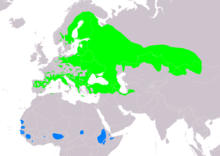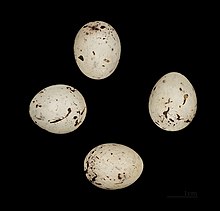Ortolan
| Ortolan | ||||||||||||
|---|---|---|---|---|---|---|---|---|---|---|---|---|

Ortolan ( Emberiza hortulana ) |
||||||||||||
| Systematics | ||||||||||||
|
||||||||||||
| Scientific name | ||||||||||||
| Emberiza hortulana | ||||||||||||
| Linnaeus , 1758 |
The Ortolan ( Emberiza hortulana ) is a bird art from the family of the buntings (Emberizidae). The ortolan is also called the garden bunting .
description
The male has a gray-green head, a yellow throat and yellow circles under the eyes. The underside is cinnamon brown. The females can be distinguished from the males by a more matt head color. The young birds are rather inconspicuous in color. The ortolan also differs from other bunting, like the goldhammer , in its shape. The tail (in contrast to the goldenhammer) is cut straight and the wings are longer and narrower. The physique is rather slim. The ortolan can be confused with the gray ortolan ( Emberiza caesia ), which in Europe only occurs as a summer guest in the region around Greece and in Turkey. The Grauortolan, however, has a grayer head. With a length of 17 cm and a weight of 20 to 28 g, it is roughly the size of a house sparrow. It feeds on seeds and insects.
Distribution area and habitat
The ortolan is a pronounced migratory bird . It winters in subtropical Africa north of the Sahel in the area south of Morocco and in Ethiopia. After a five-month stay, it returns to the breeding area in April or May. As a summer visitor, the Ortolan lives in large parts of the European continent. Exceptions are some parts of Spain, western France, Denmark, most of Norway, and Iceland and Great Britain. In northern Germany, the Lüchow-Dannenberg district is a focus with almost 900 districts (as of 1999). In southern Germany it has its last territories at the Maindreieck ( Lower Franconia ) with a population of approx. 300 singing males (as of 2003). In Tyrol there is the Silz-Haiming-Stams Ortolan deposit , currently the only known regular breeding area in Austria and a European bird sanctuary (Natura 2000 Type A ⊙ ). In Switzerland there are only single couples in the Valais .
He prefers dry, warm locations (e.g .: terraced vineyards, dry grassland, cultivated areas and rock steppes). He prefers rather open areas with isolated bushes for cover. In Main Franconia it used to be the extensive orchards (with the fruit trees as a singing point ). It mainly breeds in grain fields along windbreaks and forest edges and in the last orchards. A singing station in the vicinity (approx. 20 m) of the breeding habitats is usually mandatory.
singing
The ortolan sings mostly from bush or tree tops as well as from telegraph lines. In Franconia , his Singwarten are tall fruit trees and oaks in windbreaks and on the edges of the forest with fields in front of them. Often he also sings in flight. The singing sounds like "zri-zri-zri-zri-djü-djü-djü" or "ridri-dri-dri-jööj". Ortolan males each have 2-4 different stanzas. When excited they call "psip" or "psie", often alternating with a call "djüb". The singing is usually typical of the region. That means, for example, you can distinguish Polish Ortolans from Franconian Ortolans by their vocals. Wherever neighboring vocal dialects meet, mixed singers occur with a certain regularity who alternately recite one and the other dialect (alternative dialect mixed singers; ADMS) and / or combine elements that characterize their dialect in a stanza (combination dialect mixed singers; CDMS). For example, along the Ortolan circular route in the Nuthe-Nieplitz Nature Park in Brandenburg , between Stücken and Körzin, representatives of the Fläming dialect population , the Lausitz including their mixed singers, “Fläming-Lausitz” can be heard.
Brood
The Ortolan is a ground breeder that breeds twice a year. The nest (hollow in the ground) consists of stalks, grasses and mosses as well as hair and finer grasses for upholstery. The female lays 4–6 eggs, which vary greatly in color. These are incubated for 10-14 days. The nestling duration is 10–15 days.
In Franconia, the Ortolan breeds mainly in grain and usually only once a year (Mainfranken at the Maindreieck). The nest upholstery here is a "mat" made of fine roots.
Existence and endangerment
The species is not endangered as such (IUCN Least Concern), but its population is decreasing regionally. In the federal states of Lower Saxony and Bremen, Ortolan has been classified as endangered since 2015. In the Red List of Germany's breeding birds from 2015, the species is listed in Category 3 as endangered. Their German breeding population is estimated at 10,500 to 16,000 breeding pairs for the years 2005 to 2009.
The species is particularly affected by the ever-increasing destruction of the biotope. In Franconia, this is particularly due to the decades of clearing of fruit trees on arable land (orchards), land consolidation and changes in the cultivation methods for crops. In Switzerland, the number fell from around 200 in 1996 to 7 in 2009.
When assessing the endangerment of the ortolans, however, it should be borne in mind that Germany, Austria and Switzerland lie in the area of the western limit of distribution of the species and that ortolans, especially in the west of these countries, have never been or have always been absent.
Others
The song of the Ortolan is said to have inspired Ludwig van Beethoven to write the Fifth Symphony .
Despite strict fishing bans, Ortolans are considered a delicacy (" Fettammer ") in southern France.
Web links
- Emberiza hortulana in the endangered Red List species the IUCN 2008. Posted by: BirdLife International, 2008. Accessed January 31 of 2009.
- Videos, photos and sound recordings for Emberiza hortulana in the Internet Bird Collection
- Entry at the Swiss Ornithological Institute
- Age and gender characteristics (PDF; 1.7 MB) by Javier Blasco-Zumeta & Gerd-Michael Heinze
- Ortolan's feathers
Individual evidence
- ↑ Wendland-Lexikon Volume 2 LZ, Wolfgang Jürries (Ed.), Lüchow 2008, ISBN 978-3-926322-45-6
- ↑ Site code: AT3312000 ( page no longer available , search in web archives ) Info: The link was automatically marked as defective. Please check the link according to the instructions and then remove this notice. . Natura 2000 Data Form (pdf); Natura 2000 Tyrol. In: tirol.gv.at »Topics» Environment »Nature conservation. Tyrolean provincial government, accessed in 2010 (regional map (tiris), data sheets (data form), listing of EU habitats and species, management plan (text), management plan (maps)).
- ^ Peter Schubert: Striking chants performed with dialect. In: Land in Sicht , No. 9, 2006. Ed .: Landschafts-Förderverein Nuthe-Nieplitz-Niederung e. V., pieces and nature park administration Nuthe-Nieplitz, Dobbrikow. P. 15. ISSN 0946-6762 .
- ↑ Emberiza hortulana on the IUCN Red List
- ↑ Thorsten Krüger, Markus Nipkow: Red List of Endangered Breeding Birds in Lower Saxony and Bremen, 8th version, as of 2015 . Ed .: Lower Saxony State Agency for Water Management, Coastal Protection and Nature Conservation. tape 35 , no. 4 . Hanover April 2015, p. 194 .
- ↑ Christoph Grüneberg, Hans-Günther Bauer, Heiko Haupt, Ommo Hüppop, Torsten Ryslavy, Peter Südbeck: Red List of Germany's Breeding Birds , 5 version . In: German Council for Bird Protection (Hrsg.): Reports on bird protection . tape 52 , November 30, 2015.
- ↑ Gavino Strebel: Ortolan shortly before extinction , Naturschutz.ch, March 21, 2010
- ↑ Bird protection camp against the beginning of the Ortol in southern France. In: komitee.de. Bird Murder Committee , accessed July 16, 2020 .


